|
THE GASPARILLA CELEBRATIONS OF 1905 & 1906
|
YE MYSTIC
KREWE 1904 RECAP
Ye Mystic
Krewe of Gasparilla made their debut in Tampa's 1904 May
Festival as a small contingent of masked,
courtly-mannered, royally and "gaily" dressed men
"prancing around on horseback." It was
not staged as an invasion; it was promoted as a
"friendly visit." The grand finale
of the festival was a grand royal ball at the Tampa Bay
Hotel casino where the identities of the King, Queen, and
the court of Gasparilla were revealed.
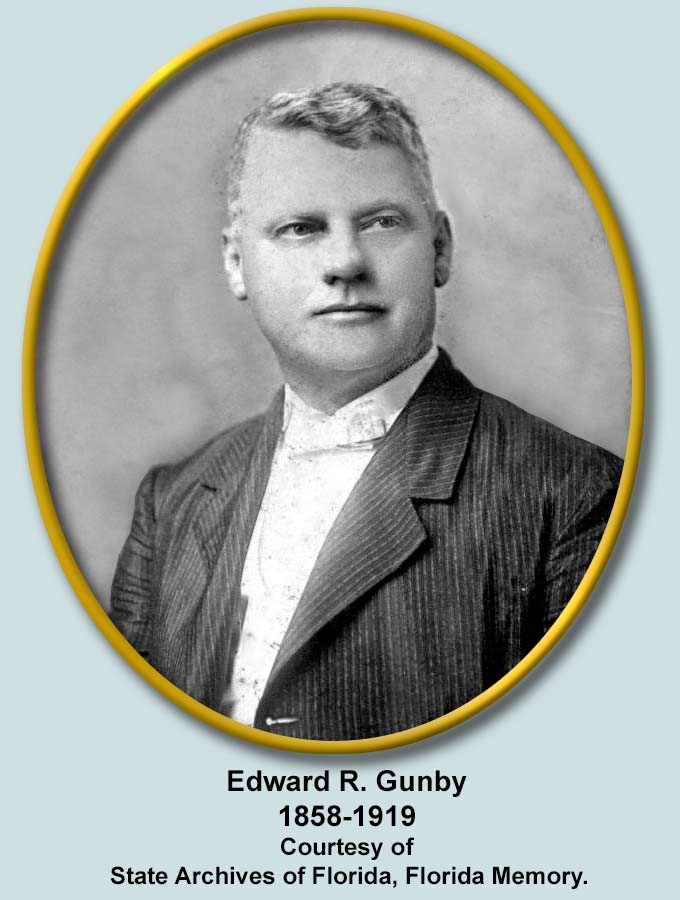 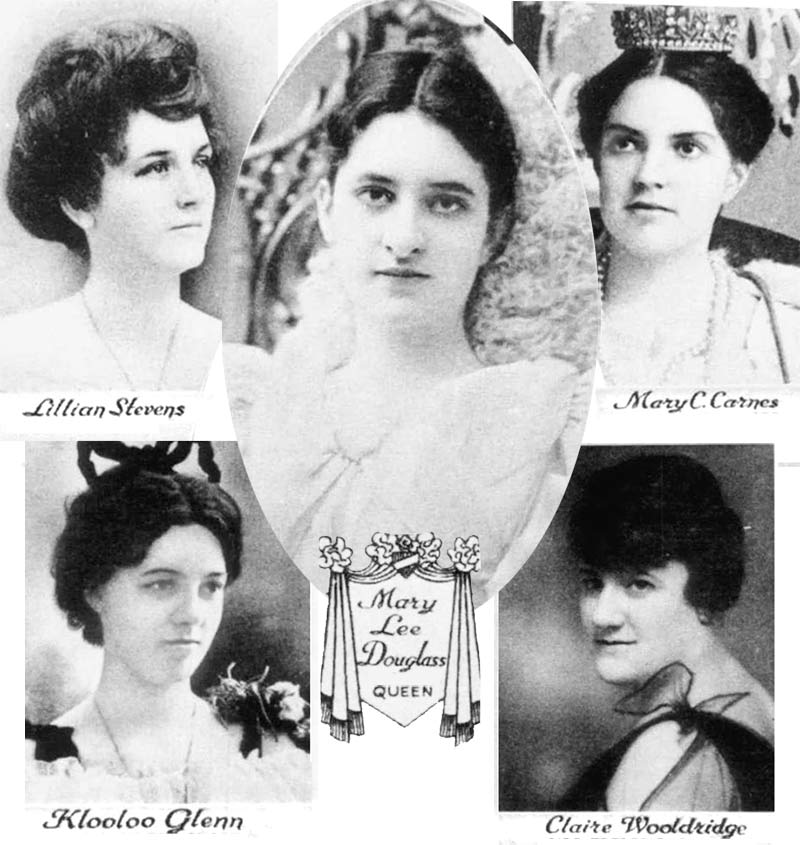
|
|
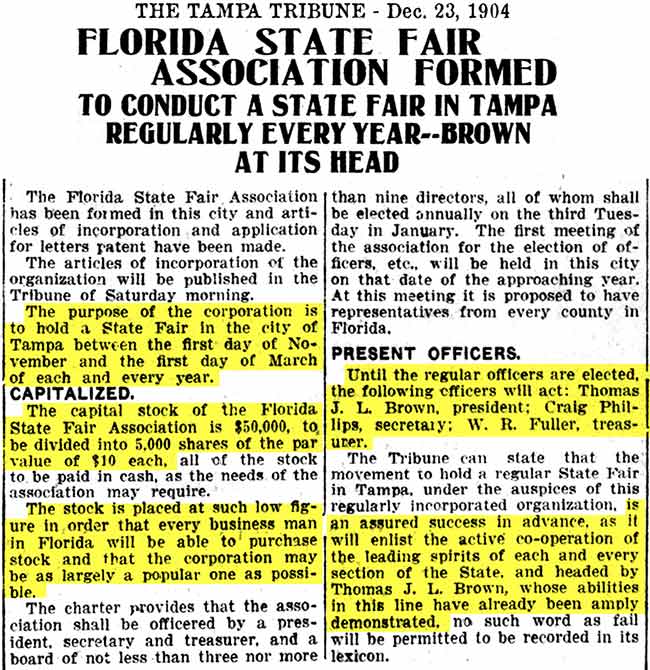
|
FLORIDA STATE FAIR ASSOC. FILES FOR
INCORPORATION
On Dec. 23, 1904, the
Tribune announced that a Florida State Fair
Association had been incorporated. With
capital stock of $50,000 at $10 per share, the
price was placed low so that "every businessman in
Florida will be able to purchase stock and that the
corporation may be as largely a popular one as
possible."
The charter
provided for anywhere from three to nine directors
to be elected annually.
President Thomas J.
L. Brown held 480 shares, secretary Craig Phillips
10 shares, and and treasurer Fuller 10 shares.
Some
sections have been omitted below. Section
II stated that the general nature of the business to
be conducted was to hold a State Fair between the
first day of November and the first day of March,
each and every year...
See the whole article. |
|
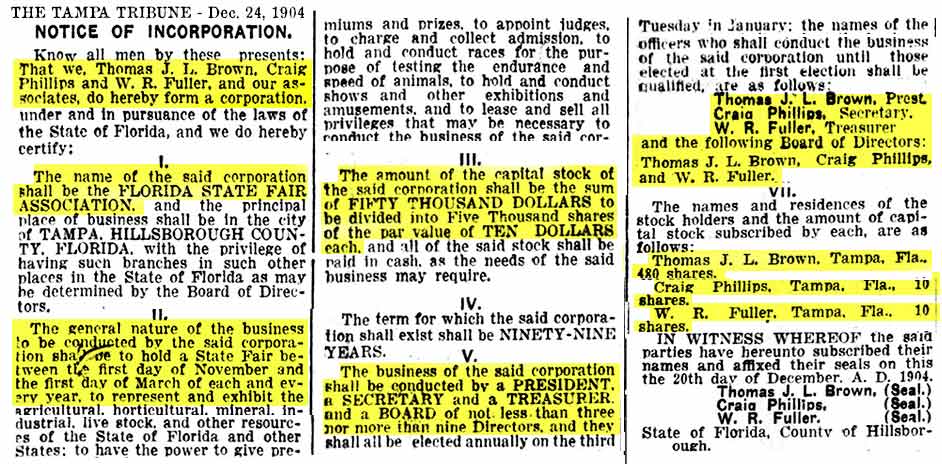
|
|
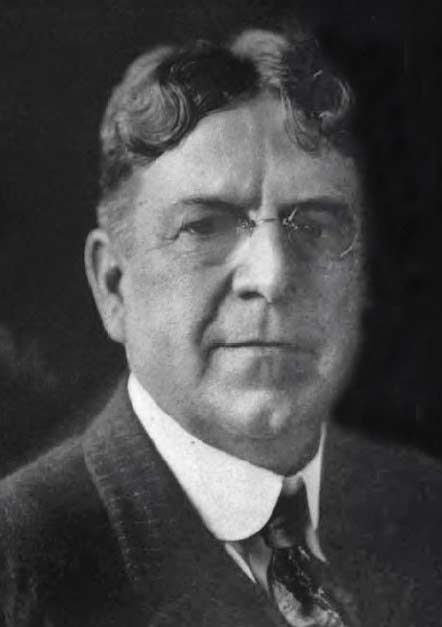 WILLIAM
REED FULLER - From "Men of the South" etc, 1922 WILLIAM
REED FULLER - From "Men of the South" etc, 1922
Born at
Hendersonville, N.C. March 24, 1867, he received his
education in the public schools of Atlanta, Ga.
He moved to Florida as a young man and soon became
one of the recognized factors in the building up and
development of the State. Mr. Fuller was
manager of the first steamship line that operated
between Tampa and Mobile in 1887 and 1888.
Upon locating in Tampa he became Commercial Agent of
the Florida Central and Peninsular Railroad, and
when this was absorbed by the Seaboard Air Line (a
railroad line) he became its General Agent. He
was manager of the Independent Line of Steamers
operating passenger and freight boats for eleven
years. Afterwards, he entered the wholesale
grocery business as a partner of Phillips & Fuller
from 1895 until 1902. He then formed the firm
of W. R. Fuller & Co. which operated until 1910.
Recognizing the growing demand for building and road
materials to to the rapid growth of Florida, he
entered that line of business and has been
continuously in it, his being the largest of its
kind in the State. He is presently engaged in
developing rock, sand and mineral filler plants for
building roads and houses throughout the State.
Before his success in this field, a great deal of
these materials had to be shipped to Florida from
other states. He has always taken a keen
interest in public affairs. For six years he
was president of the Tampa Board of Trade during a
time which Tampa attained remarkable growth.
He was personally instrumental in bringing many new
citizens and large new capital to Tampa and the
vicinity. He was chairman of the Board of
Public Works of Tampa for four years during which
time some of the most important public improvements
were initiated throughout Tampa. He is a
member of the Tampa Yacht and Country Club and local
golf clubs, Knights of Pythias, Elks and other
clubs. He has always given freely of his time,
money and efforts to every movement for the material
and moral advancement of Tampa and has been
identified actively with all civic endeavor for
better things. Mr. Fuller was married March
17, 1891 to Miss Bertha E. DeTar, daughter of Dr.
Theodore DeTar of Bradentown. |
|
TAMPA BAY HOTEL FOR SALE
With the estate of H.B. Plant
settled a few years earlier, Mrs. Plant and his son,
Morton Plant, arranged for their holding company to sell the
palatial Tampa Bay hotel, but this was then tied up in litigation
between Frank Q. Brown of the Ocean and Gulf Realty Co who had
charge of the remaining assets of the Plant System, and Chas. H.
Scott of T.J. Scott & Sons, claimants of the hotel property
under an option.
This was finally settled out of court in Dec.
1904, when the two parties realized the ongoing litigation would
be expensive. As part of the settlement, Frank Q. Brown reimbursed the Scotts $25,000 for the
funds they had spent on the property and the hotel would be
conveyed to Brown. He then closed
the hotel on Dec. 9, 1904. This worried many that the hotel
would be bought and demolished.
The hotel's off-season manager, Thomas J.L. Brown, had worked to reopen the hotel and
keep his job after having been
closed by Frank Brown. In the hotel's eleven years, and
the casino's nine years of existence, they had been the venue
for thousands of Tampa's big social, cultural and civic events.
One of the events the hotel was a key to success for was the South
Florida Fair which up to this point had been a local event
with some participation by about ten other counties. Brown had played a crucial
role in making this fair and the May Festivals a success.
**The Casino was not a place of gambling. It was what we
would call a theater/auditorium/convention center today.
It also had a swimming pool under the auditorium floor.
Read more about
the Casino.
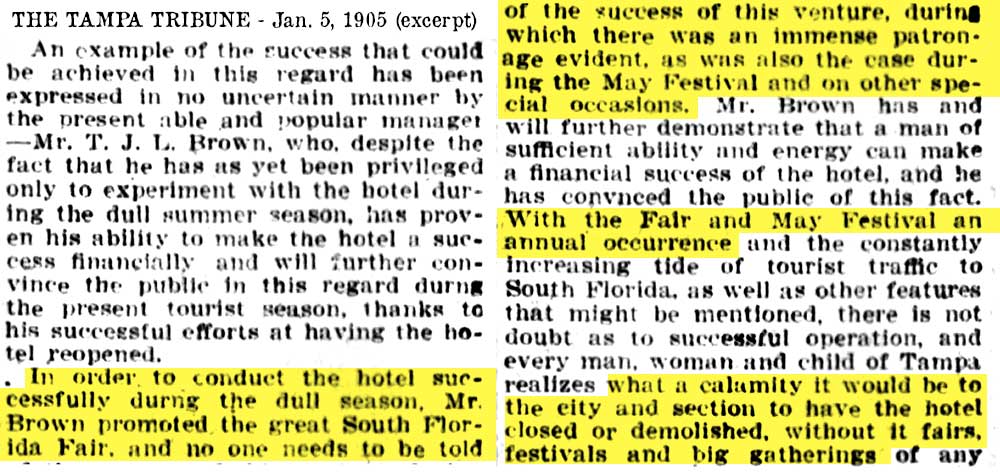
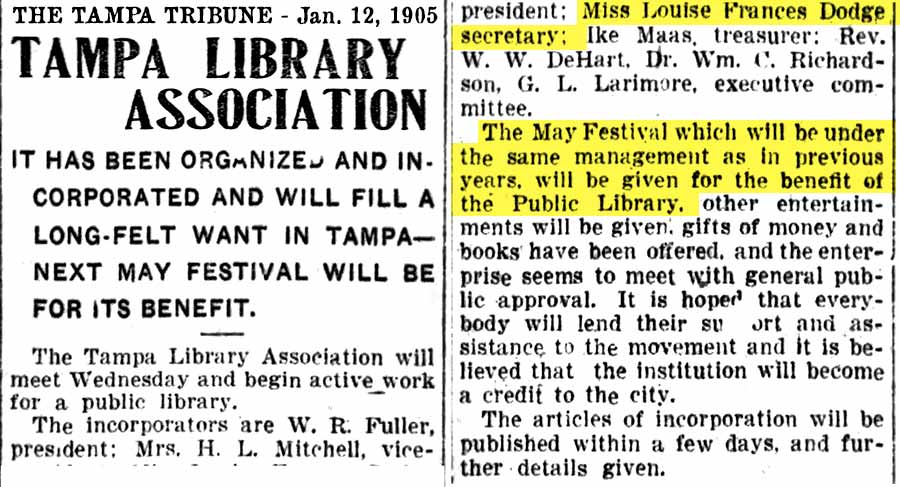
LIBRARY ASSOC. EXPECTS A MAY
FESTIVAL
In mid-January 1905
a library association was formed with Louise Dodge as secretary.
Louise had already resigned from the Tribune and had become a
history teacher at Tampa Preparatory School and in ten days
would join the staff of the Jacksonville Times-Union as their
Tampa correspondent.
The
Association planned to use the May Festival as a fundraiser, but
as of yet, no plans had been announced to hold the festival.
|
|
ANOTHER
STATE FAIR INCORPORATION
Less
than two months after the Florida State Fair
incorporation of late Dec., 1904, another
incorporation was filed as "The Florida State
MID-WINTER Fair Association" with W. F. Stovall
replacing W. R. Fuller as treasurer. Stovall
was owner and publisher of the Tampa Tribune.
No explanation was given for the new name or the
replacement of treasurer Fuller. Thomas J. L. Brown
remained as president, J. Craig Phillips was
secretary, and Stovall the treasurer.
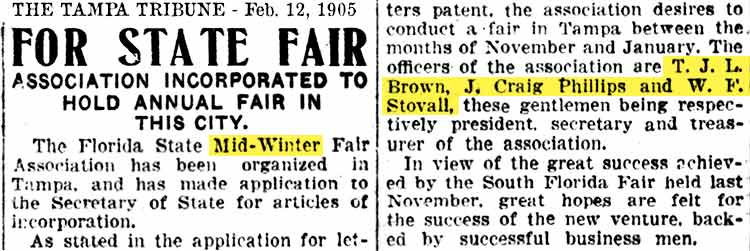
This
incorporation also stated the same period to hold
the fair,
between the first day of November and the first day
of March, each and every year...
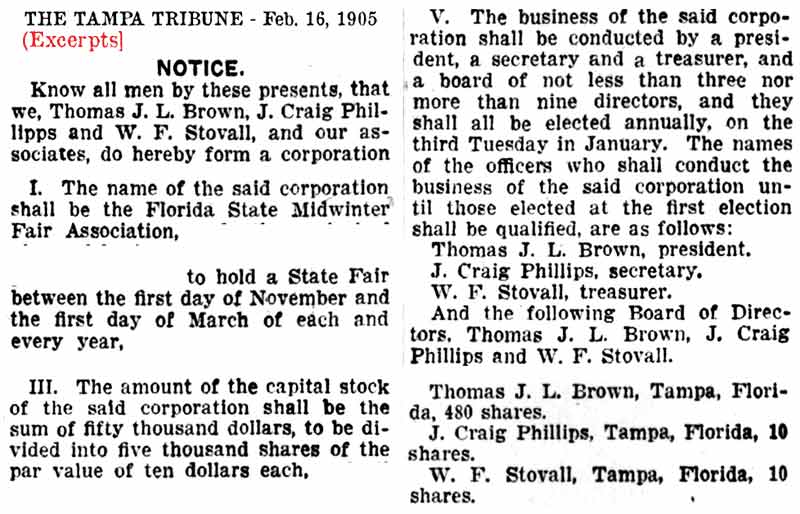
See the whole article.
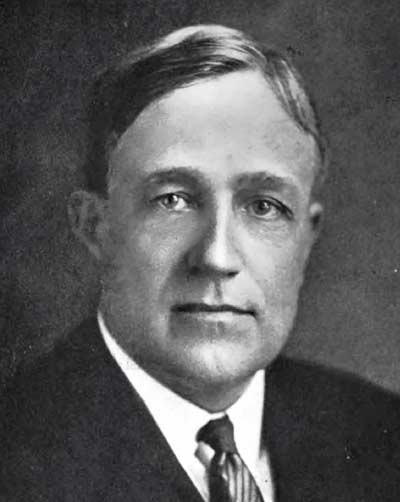 |
From "Men of the South, A Work for
the Newspaper Reference Library"
(Stovall was the Tampa editor.)
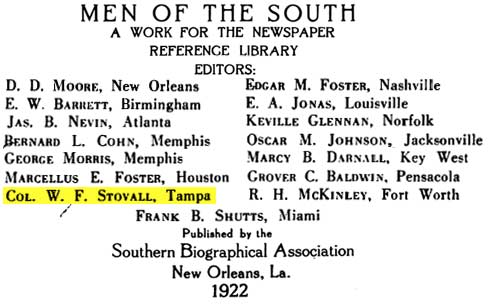 WALLACE
FISHER STOVALL (1922) WALLACE
FISHER STOVALL (1922)
"W.F.
Stovall, President and Manager of The
Tribune Publishing Co. of Tampa and
editor of The Tampa Tribune is not only
a conspicuous example of success
achieved by patient and untiring effort,
but by reason of the well-directed work
done through his paper for the benefit
of Tampa and the State of Florida, has
become one of the most valued and
indispensable citizens of that great and
growing commonwealth. Thrown at an
early age entirely at his own resources,
he has steadily climbed upward on the
toilsome ladder of public life, and
while yet a young man, has reached a
position of great influence in the field
to which is labors have been
consistently and exclusively devoted." |
|
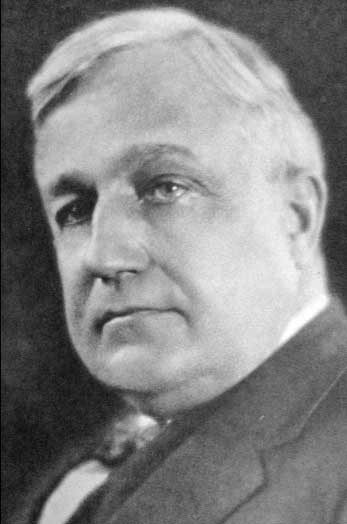
Born in Elizabethtown, Ky on Jan. 4,
1869, the son of Jasper and Eliza
(Duncan) Stovall. Left an orphan
at age five, he spent his early years on
a farm while attending public schools of
his native town. He moved to
Florida in 1886 at 17 years old and
entered into the business life with a
job at a country newspaper at Lake Weir
and later Ocala, Sumterville, then
Bartow. Starting at the "bottom"
he learned the business first in the
laborious print shops. In 1890 at
age 21, he established The Polk County
News at Bartow, at which he was the
owner, editor and general manager, and
often the printer and pressman.
He saw an inviting opportunity in Tampa
and so his Polk County News was left
behind in Bartow for a promise of future
commercial importance. In 1893 The
Tampa Tribune was born. The paper
soon kept the pace of development and
advancement of Tampa and went from a
"blanket sheet" with out-of-date
equipment and limited circulation to
become in 27 years the leading journal
south of Jacksonville, with modern
equipment, Associate Press service, and
the largest, most complete, it became
the most prosperous and progressive
newspaper in South Florida. He
recently completed the construction of
the W. F. Stovall building, a modern
seven-story office building. He is
a member of the Benevolent and
Protective Order of Elks, and a Mason.
Wallace F. Stovall died on Apr 16, 1950
at age 81.
Read his lengthy obit in the Tampa
Tribune.
Read his obit in the Tampa Times. |
|
|
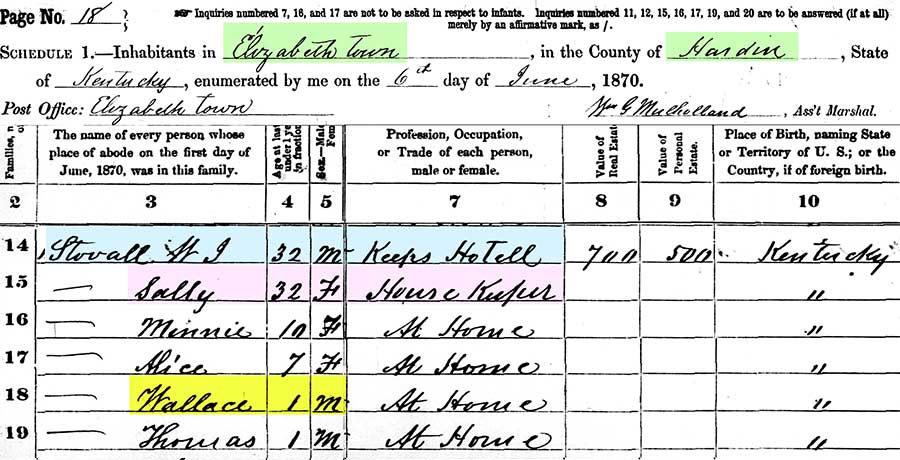
The 1870 Census of
Elizabeth Town, Ky. shows Wallace's parents were W.J.
Stovall, a hotel keeper, and Sally Stovall.
Although "Sally" could be a nickname, it's not a
nickname for Eliza or Elizabeth.
Both were born circa 1837-1838 in Kentucky.
Wallace may have had a twin brother, Thomas.
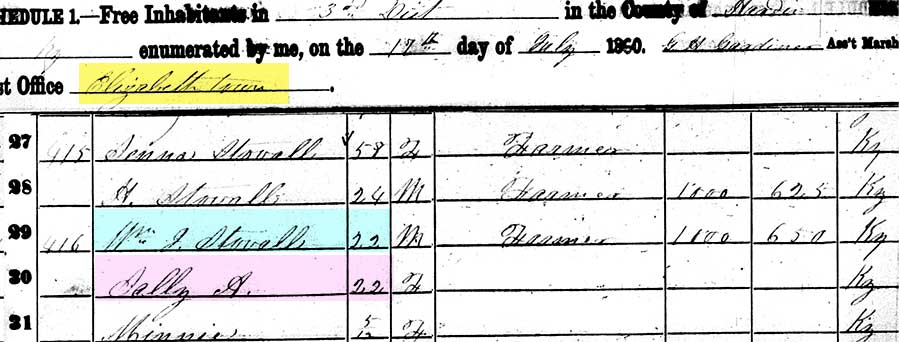
The 1860 Census shows the same family in
Elizabeth Town. Wm. J. Stovall, a
farmer, at 22, Sally A. is also
22.
Wallace's older sister Minnie was 5
months old. The Stovall's next
three children would be born after this
census and before the
1870 Census.
Listed above the Wm. J. Stovall family
is Senna Stovall of age to possibly be Wm. J.'s mother, (58) and H. Stovall (24) of
age to have been Wm. J's brother.
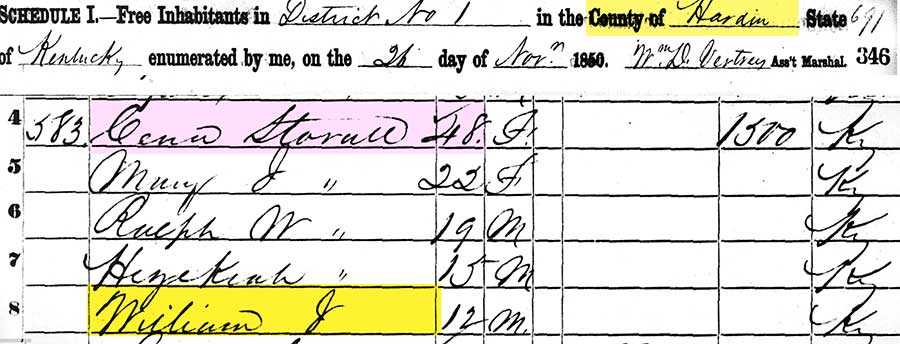
The above possibility is confirmed by
the 1850 Census of Hardin County, KY,
showing William J. Stovall (12) in the
home of "Cena" Stovall, age 48.
With probable brothers of William being
Ralph W. and Hezekiah Stovall, who was
the "H. Stovall" on the 1860 Census.
Cena was widowed before the 1850 census.
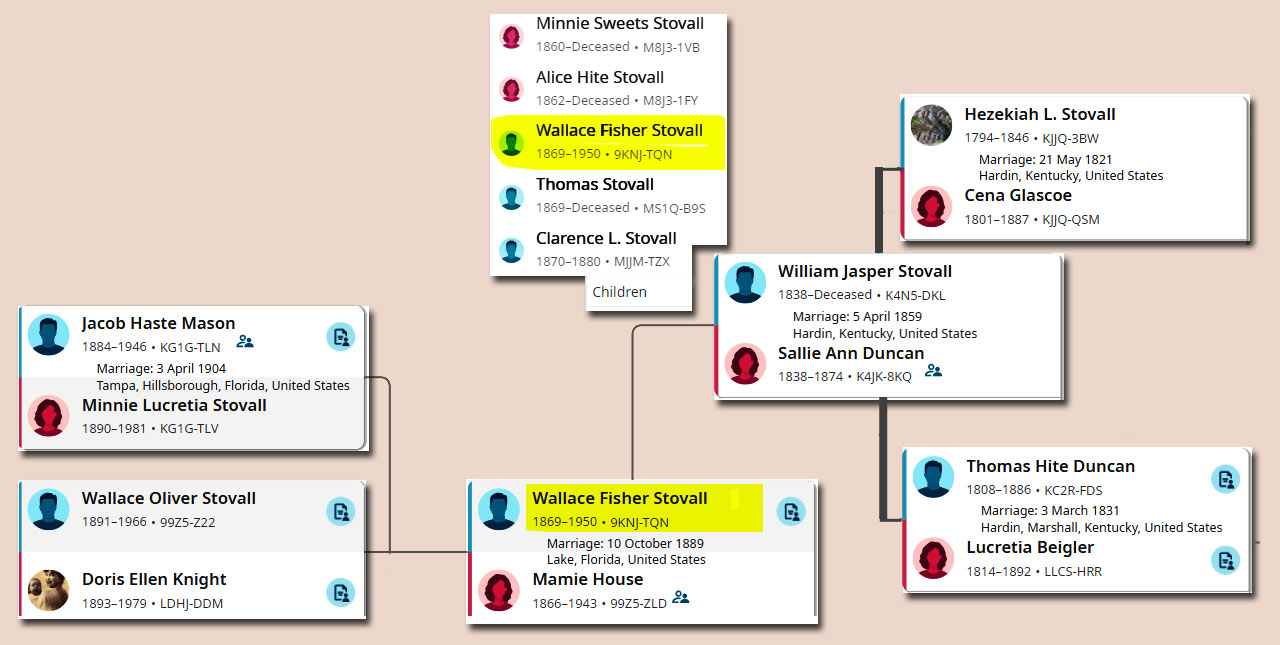 |
|
|
The new
Midwinter State Fair incorporation was followed by a blitz of
articles concerning the new midwinter fair in Tampa,
with multiple articles appearing almost daily for over a
month. Not surprising since Stovall owned the
Tribune. All designed to increase the sale of
stock and gain approval for the State Fair to be
held in Tampa. Just a handful here... |
|
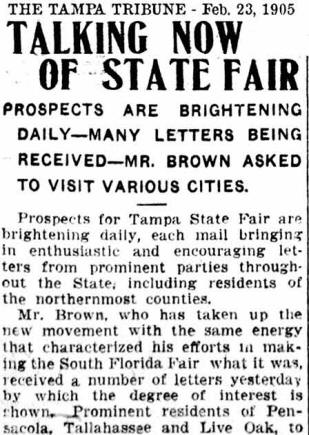
Read
the whole article |
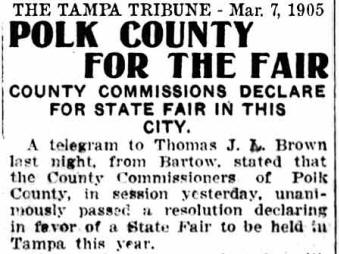
Read the whole article
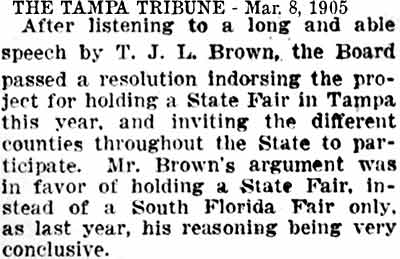 |
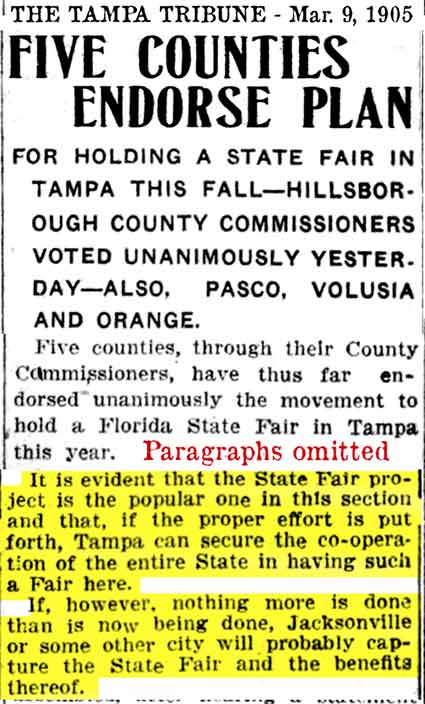 |
|
|
|
Read the whole article |
|
THEM'S FIGHTIN' WORDS! |
STOVALL GOES TO WAR WITH
JACKSONVILLE TIMES-UNION
Stovall in effect calls the Jax newspaper "fake
news" concerning their claim that the secretary of
Tampa's Board of Trade made such a statement.
Everybody knows Tampa is the best place for the
State Fair. |
|
The
Tribune says that the Jacksonville newspaper is
pleased with statements they claimed were said by
Tampa's Board of Trade's secretary Calhoun.
"...to the effect that" Tampa didn't aspire to host
the State Fair and that Jacksonville was the proper
place for it.
 |
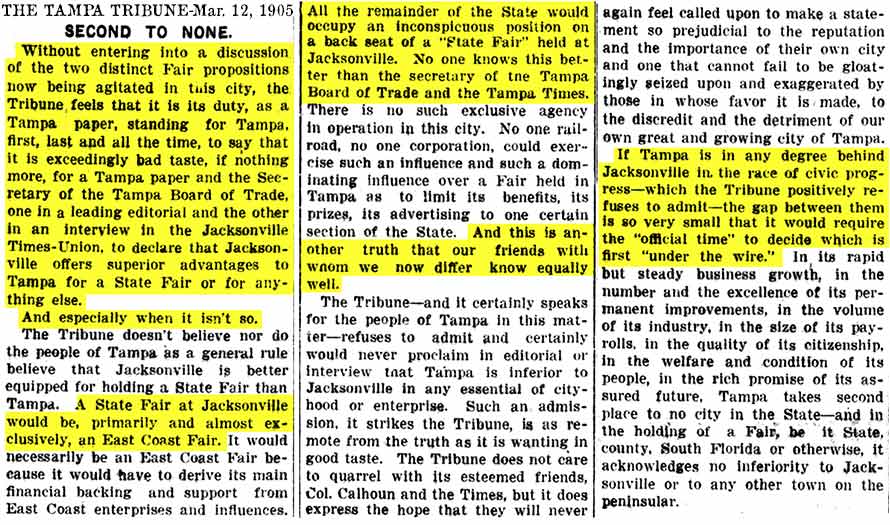 |
|
STATE FAIR MEETING HELD AT OLD (OLD) CITY HALL (The
one built in 1891 and demolished in 1914)
Representatives "from various counties" (not stated)
met on Mar. 15 to hear what the State Fair
association had to say about its plans, and offer
support for the event to be held in Tampa. The Board
of Trade's plan was adopted with a few changes.
All propositions were agreed to unanimously, though
there were some counter-propositions. The
charter was read by sections, and it was stated why
Tampa had chosen to have a state fair instead of the
South Florida Fair. It was revealed that
Jacksonville had also declared for a State Fair and
if located there, the various counties would rather
display at a State Fair instead of Tampa's local
fair. Few counties would participate in Tampa.
Thomas Brown stated that immediately after the close
of Tampa's South Florida Fair last year,
Jacksonville began plans to hold a State Fair. A
First Presbyterian church pastor presented an
amendment to the second section, that no gambling,
sale of liquor, wine, beer or other intoxicants
should be permitted on the grounds. He had
witness gambling out in the open at the South Fla.
Fair and called it shameful and disgraceful to the
city and to the Fair.
Red
lines mark where parts have been deleted for
brevity, including T.C. Taliaferro's response to
pastor J. G. Anderson regarding booze at the fair.
SEE THE WHOLE ARTICLE.
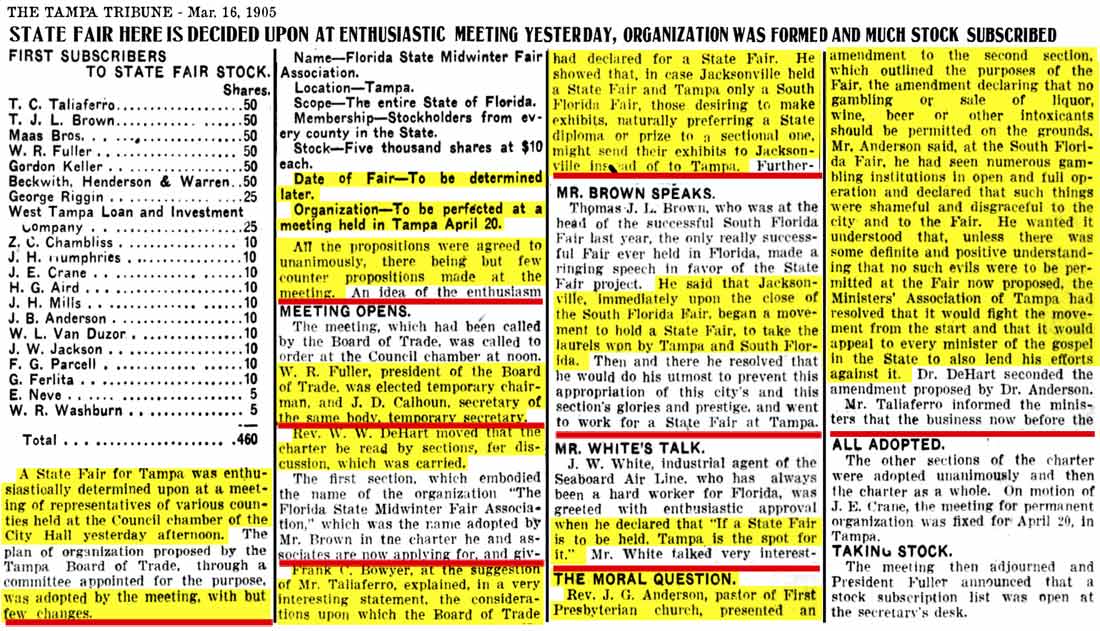
The cost of one share,
$10 in 1905, is equivalent in purchasing power to
about $359 today.
Fifty shares of State Fair stock in 1905 would be
like $17,950 today. |
| |
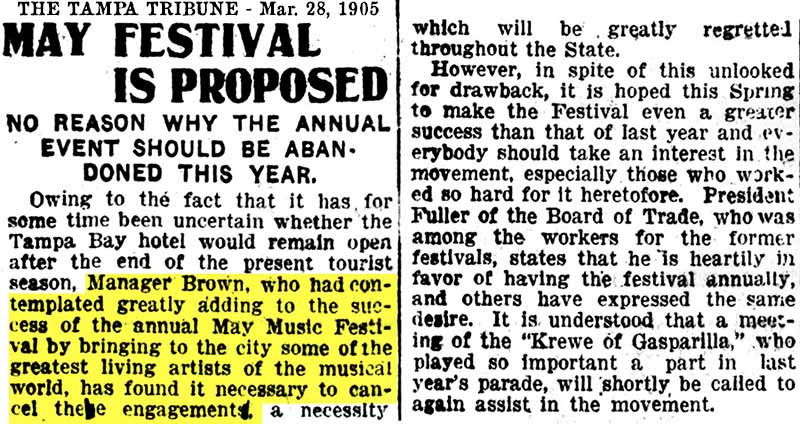 |
In late March 1905, hope for a
successful May Festival was lost when "Manager Brown, who had
contemplated greatly adding to the success of the annual May
Music Festival by bringing to the city some of the greatest
living artists...found it necessary to cancel the
engagements..."
The Tribune was still optimistic the festival would be held and
claimed a meeting of the Krewe of Gasparilla was to be called to
assist in the movement.
This didn't happen, and this was
the last article found concerning plans for a May Festival in
1905. |
The writing on the wall could be interpreted by now that
Brown, having formed the Florida State Fair Association,
was putting his efforts into promoting the first
Florida State Fair in the fall and probably had no time
to plan a concert for a May Festival. |
|
 |
|
 |
| CITY OF
TAMPA BUYS TAMPA BAY HOTEL
On June 22, 1905, the
Tampa Bay Hotel was sold to the City of Tampa for
$125,000.
Read a condensed version of this article.
Read the whole article (When it opens, click it
again to see full size.
This probably
brought a sigh of relief for most Tampans. But
many must of wondered how the city was going to pay
for repairs and improvements, and if it would
continue to be used as a hotel.
|
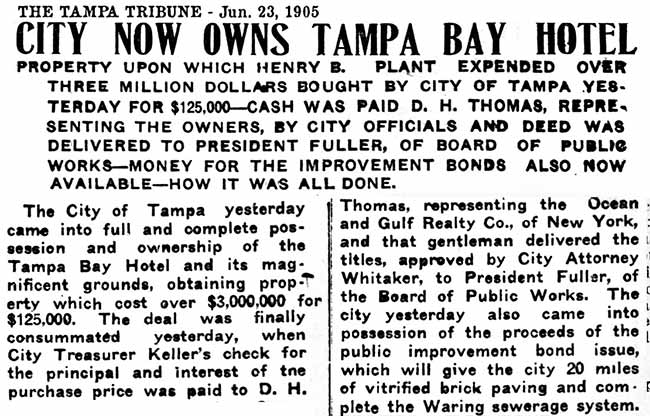 |
| |
|
WHO WAS T. J. L.
BROWN?
"He was a veritable dynamo of ceaseless energy and had
the happy and rare faculty of imparting that energy to
others who were working with him."
"His was a creative mind and once committed to a
project, no matter how large or seemingly impossible, he
knew no rest until he had made it a success."
"A man of big heart and broad ideas, generous to a
fault, true as steel in friendship and devotedly
diligent to whatever task might be imposed upon him."
"He was of such a progressive, energizing and optimistic
spirit as to make him a great asset to any community or
any cause with which he was affiliated."
A man of "nobility and generous and unselfish purpose
which entitles him to our warmest admiration and
love..."
"The Senator from Key West."
"A born diplomat."
Thomas Jefferson Laud-Brown can best be described as a
successful and ardent , promoter, hotel manager, host, and
lobbyist. Born in New York City in 1853, he
first came to Florida 1893 and settled in Green Cove
Springs where he became a large, successful and
well-known tobacco grower.
1895-08-11 NY TIMES - Thomas J. Laud-Brown of NYC,
staying at Hotel Childwold at Lake Massawpie, NY.
1897-02-12 Pensacola News - Feb. 9. Meeting of officers
Florida State Tobacco Growers Assoc. at Green Cove
Springs - Treasurer T. J. Laud-Brown.
He soon
was elected as Mayor in 1897 and continued promoting
Florida as a top quality tobacco producer and had many
articles about it published in Florida Newspapers,
including the Florida Agrigculturalist. He then
moved to Quincy and continued his tobacco farming and
experimentation. Brown made frequent trips back to
New York and moved there around 1900, still maintaining
his tobacco planations. There is strong evidence
that he owned and/or managed hotels in New York,
including the in 1902 with the firm that had just bought
the Tampa Bay Hotel. He was a successful promoter of
the South Florida Fair in Tampa from 1902 until 1905
when
he incorporated the Florida State Fair Association.
He then put all his efforts into promoting the State
Fair and lobbied successfully to have the State
Legislature provide funds for it. In 1907 he announced
his candidacy for the Florida senate but stepped down
before the election in Nov. 1909. In 1909 he lobbied the
U.S Congress and convinced them to officially name Tampa
as the closes port in the east to the Panama Canal which
was in the planning stages. He then pushed for a
grand Panama Canal celebration which took place in Tampa
in 1910. In 1911
he left Tampa to reside in Key West to promote the
overseas railroad to Key West and the Panama Canal. Then he moved to Washington
D.C. to promote them and other Florida interests with
congressmen.
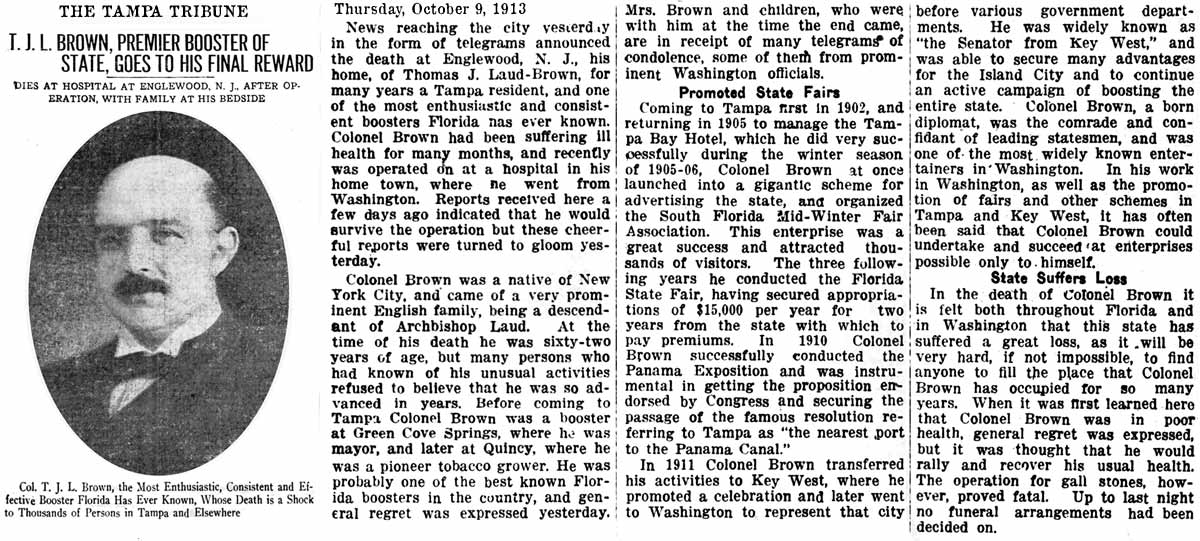
Brown's visit to Tampa in 1902 to view property for
T.J. Scott & sons.
https://core.ac.uk/download/pdf/159471439.pdf
Late in May 1907, John Beard announced that he had
definitely decided to challenge Senator Mallory. An
attorney and state senator. Beard confided to a
correspondent of the Tampa Times that he would run a
one-platform campaign. "I shall," stated Beard, "make a
direct issue of my proposed constitutional amendment
repealing the fifteenth amendment, the purpose of my
amendment being to disfranchise the negroes." By June,
the press of the state had added Thomas J. Laud Brown of
Tampa, state Senator Frank Adams of Jasper, and William
J. Bryan of Jacksonville to the list of possible
contenders. Late in the month. Brown, former
manager of the Tampa Bay Hotel and president of the
state fair, officially joined the race. A commentator
described Brown as belonging to "neither of the
political factions" and as "a tireless worker" but "not
a speaker." In an interview. Brown described a program
of encouraging immigration to Florida, building "deep
water" ports in the state, and "Progressiveness for
Florida in every line of endeavor."
In analyzing the approaching race, a Tampa newspaper
predicted that Trammell would base his campaign on the
curbing of corporations and the enactment of a franchise
tax. Beard would run solely on the issue of Negro
disfranchisement, and Bryan would enter the lists as the
"Broward candidate." The paper did not mention Brown,
evidently believing his candidacy to have proven
abortive. PARK
TRAMMELL OF FLORIDA: A POLITICAL BIOGRAPHY By STEPHEN
KERBER |
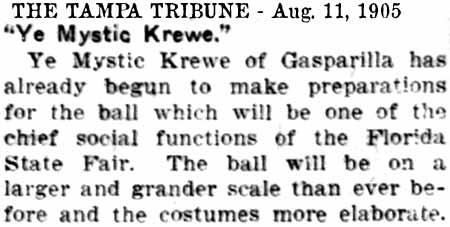 FIRST
MENTION OF YE MYSTIC KREWE OF GASPARILLA IN 1905 FIRST
MENTION OF YE MYSTIC KREWE OF GASPARILLA IN 1905
Ye Mystic Krewe
began making plans in August for the state fair.
They claimed it would be on a larger and grander
scale then ever before, with more elaborate
costumes.
|
| |
|
DETAILS OF THE GASPARILLAS' FORMATION WAS NOT MADE PUBLIC UNTIL 1913
It
wasn't until 1913 that the behind-the-scenes story of how the Gasparillas'
debut came to be was first revealed in the Tribune. The celebration having moved
in 1905 to coincide with the start of the
Florida State Fair, Gasparilla was in the news, as
it was every year it was held. The article
was incorrect about "the first publication" being
from "the Pirate Chief himself." It was from "Gossippo,
Lord High Chamberlain; Guardian of the Pantry Key."
It was also not advertised as "Gasparilla Day"

The Feb. 21,
1914 Tampa Tribune erroneously credited Miss Dodge
for making the Gasparilla pageant suggestion to George Hardee for the
1904 May festival. In the years after this, the story would be repeated
in the Tribune at Gasparilla time, but would evolve to become
more embellished and credit Hardee for the idea. This article claimed that Gasparilla was not held
in 1905, but it was. It was 1907,
1908 & 1909 when it wasn't held.

|
WHATEVER HAPPENED TO LOUISE FRANCES DODGE &
GEORGE W. HARDEE AFTER THE 1904 MAY FESTIVAL?
|
|